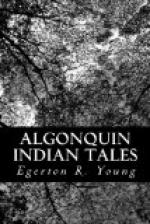“It was now in the fall of the year, and the leaves of these trees were all crimson and yellow, so brilliant that when seen from a long distance they looked like a great fire. Thus it happened that when the bad spirits following after Nanahboozhoo and Nokomis saw the brilliant colors through the haze of that Indian Summer day they thought the whole country was on fire, and they turned back and troubled them no more. Nanahboozhoo was pleased that the beautiful maple trees had been of so much assistance to him. He decided to dwell among them for some time, so he prepared a very comfortable wigwam for himself and his grandmother.
“It was in the wigwam among the maples that the deputation found Nanahboozhoo. He received them kindly, and listened to their story and their request.
“At first Nanahboozhoo was perplexed. He was such a great traveler that he had often been down in the great Southland, and well knew how the sugar was there made. He had seen the fields of sugar cane, and knew the whole process by which the juice was squeezed out and then boiled down into sugar. He also knew that it required a lot of hard work before the sugar was made.
“When Nokomis heard the request of the deputation to her grandson she was very much interested—for had not Nanahboozhoo several times, when returning from those trips to the South, brought back to her some of the sugar?—and she had liked it very much; and so now she added her pleadings to theirs that he would in some way grant them their request.
“Of course Nanahboozhoo could not refuse now, so he told them that, as the beautiful maple trees had been so good to him and Nokomis, from this time forward they should, like the sugar cane of the South, yield the sweet sap that when boiled down would make the sugar they liked so much.
“He told them, however, that it was not for the lazy ones to have, but only for those who were industrious and would carry out his commands. Then Nanahboozhoo described to them the whole process of sugar making. He told them that only in the spring of the year would the sweet sap flow. Then they were to have ready their tapping gouges, their spiles and buckets. Great fireplaces were to be built and here, as fast as the sap was gathered from the trees, it was to be boiled down in their little kettles into the nice molasses; and then a little more, so that when it cooled it would harden into sugar.
“‘Now,’ added Nanahboozhoo, ’go back to your people and tell them that it depends on their industry between now and the spring who shall have the most of the sugar you love so well.’ Then he skillfully modeled out a stone tapping gouge of the shape required to make the incision in the tree from which the sap would flow. With his knife he made a sample spile of cedar, the thin end of which was to be driven into the hole made by the gouge and along which the sap would flow. Then he told them to make plenty of buckets of birch bark, and thus be ready when the time came to secure an abundant supply of sap. Thus the art of making maple sugar first came to be known. Nanahboozhoo gave it to the Indians long ago. Then when the palefaces came they followed the same process. That is the way Nanahboozhoo showed us how to get the maple sugar.”




